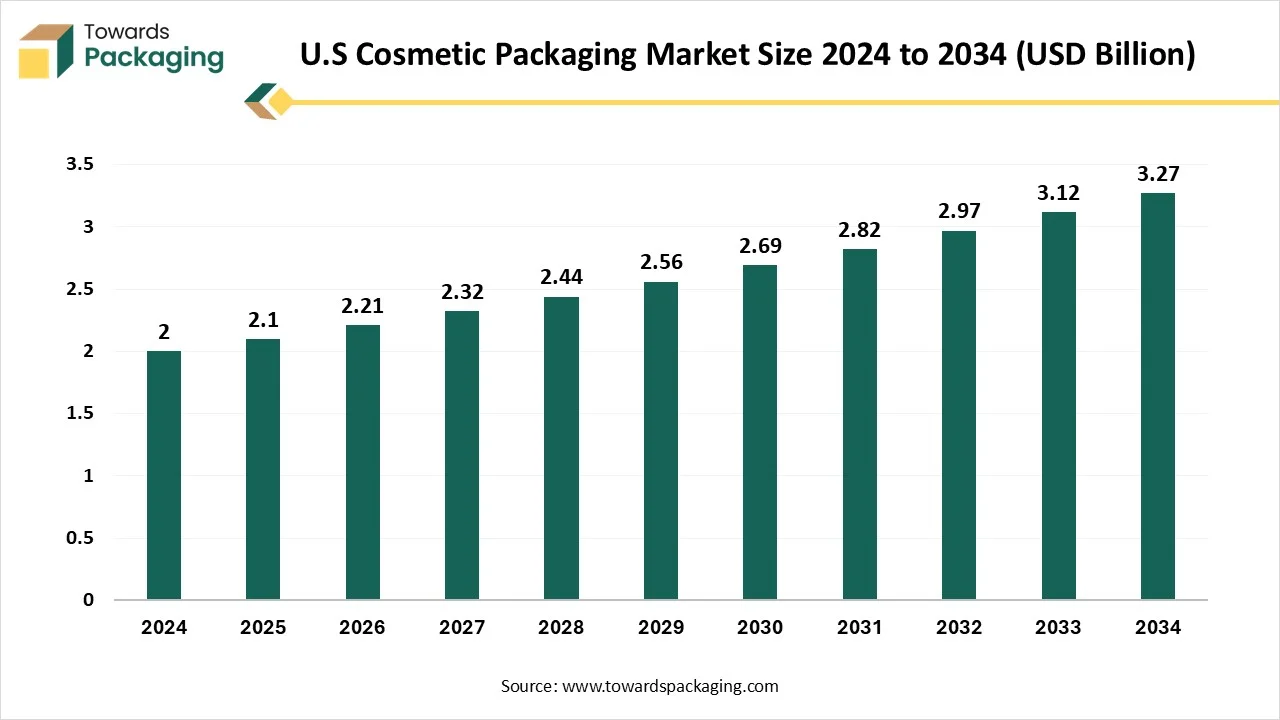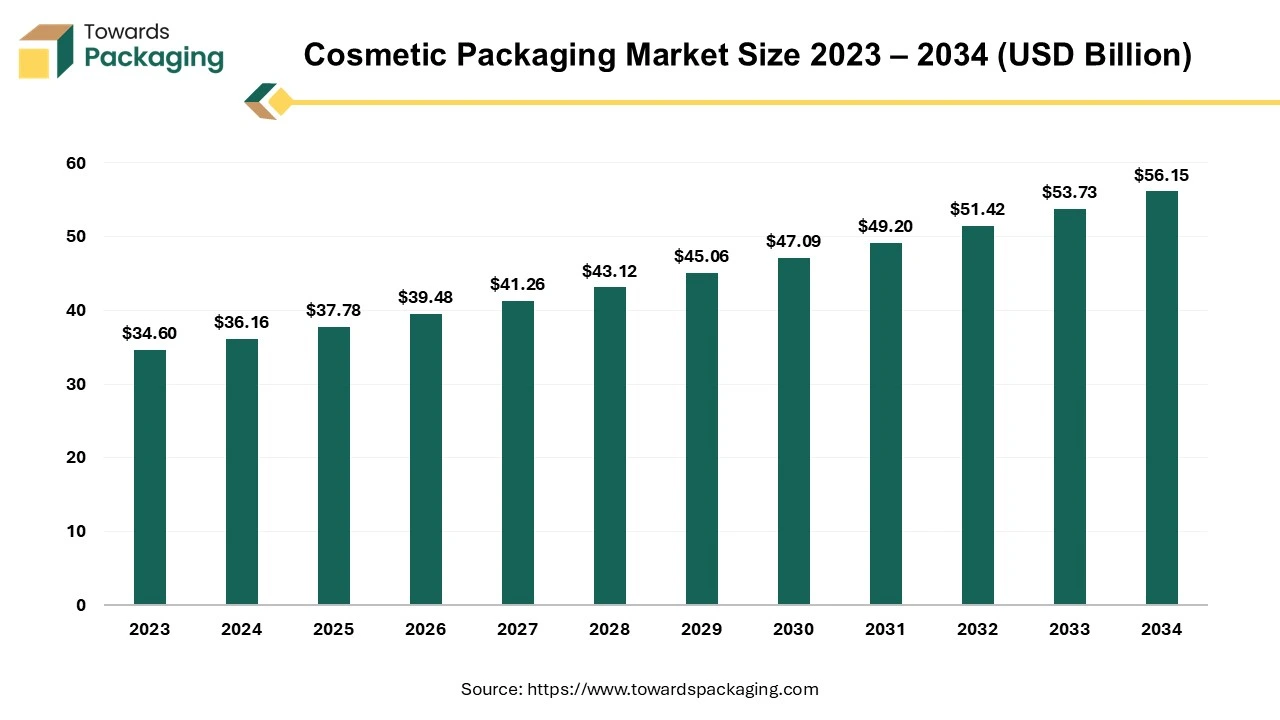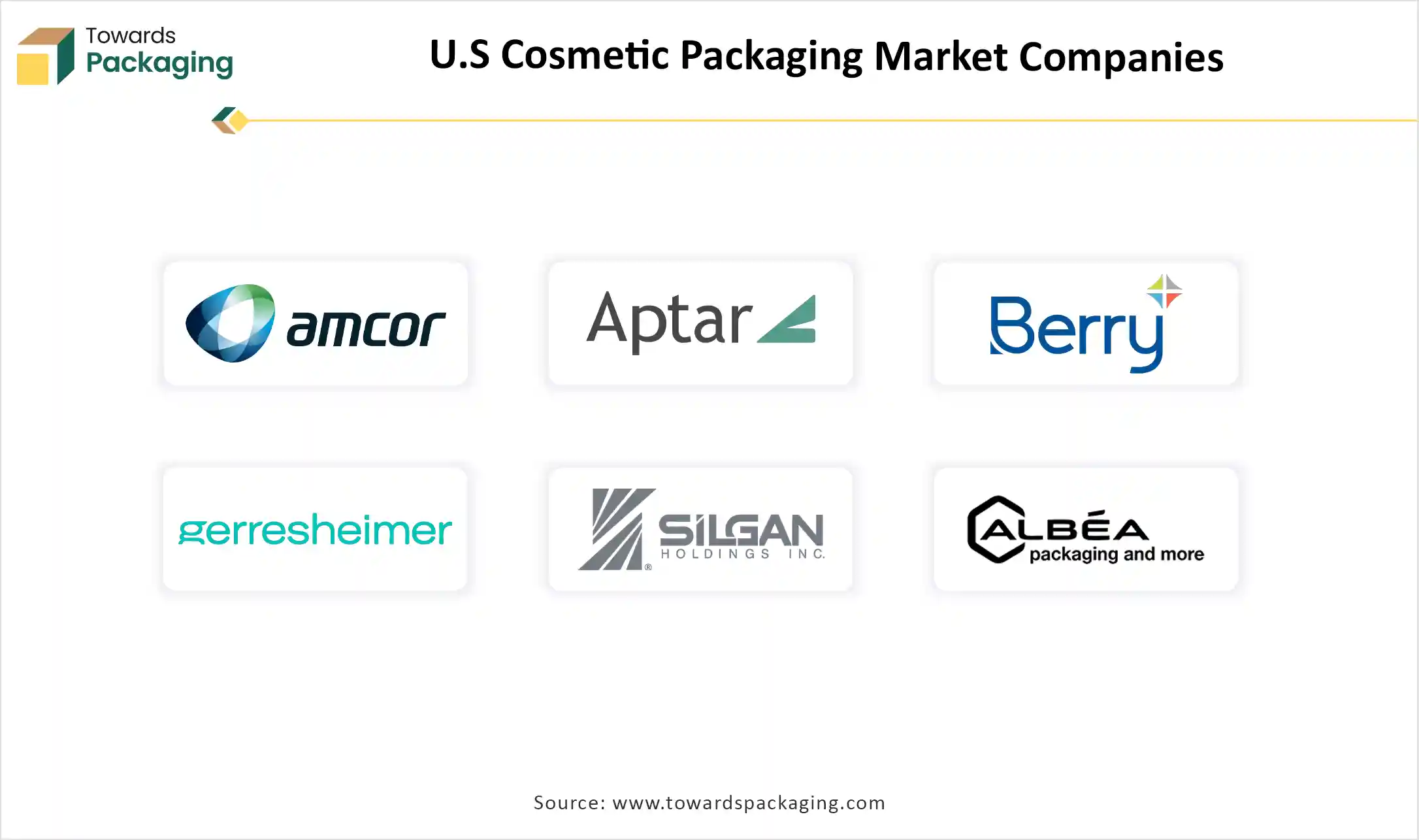November 2025
The U.S cosmetic packaging market is forecast to grow from USD 2.1 billion in 2025 to USD 3.27 billion by 2034, driven by a CAGR of 5.05% from 2025 to 2034. Growing disposable incomes and increasing consumer spending on personal care and premium products. Also, rising consumer awareness and the urge for aesthetically pleasing and functional packaging. California had the largest revenue share in 2024, but the South (Florida and Texas) was the area with the fastest rate of growth. The most popular packing style was bottles and jars, although tubes are predicted to grow significantly.
The majority of packaging was made of plastic, but biodegradable and sustainable materials will become more popular. The category of skincare goods is dominated by color cosmetics, which are expected to grow quickly. The most popular application types were creams and gels, although liquids are expected to rise significantly in the future. The primary sales channels were salons and offline stores, but in the upcoming years, it is anticipated that the internet and direct-to-consumer platforms will grow considerably.

The U.S. cosmetic packaging market refers to the industry focused on designing, manufacturing, and distributing packaging solutions used for cosmetic and personal care products. This includes primary and secondary packaging such as bottles, jars, tubes, pouches, compacts, and aerosol containers. These packaging formats serve critical functions such as product protection, ease of use, aesthetic appeal, and brand identity. With rising consumer demand for eco-friendly, premium, and functional packaging, the U.S. market is evolving across segments like skin care, hair care, fragrances, and colour cosmetics.
Artificial intelligence is increasingly adopted in manufacturing to refine production processes, minimize waste, and maintain product quality. For example, AI-powered machines monitor production lines in real-time, notifying operators of any deviations that might compromise product quality. AI algorithms analyze data from manufacturing outputs to identify ways to enhance efficiency and reduce waste. In the cosmetic and skincare sectors, sustainability concerns are prompting the use of AI to cut waste and optimize packaging design. These algorithms can scrutinize packaging options to find opportunities for reduction such as decreasing plastic usage and suggest improvements based on consumer feedback. This integration of AI helps drive both quality and sustainability goals.
Innovation, sustainability trends, and customer preferences all influence the U.S. cosmetic packaging business. One of the main causes is the growing desire for high-end, customized cosmetics, which feeds the demand for packaging that is both aesthetically pleasing and useful. Packaging is a vital strategy for brand differentiation since consumers are increasingly associating attractive packaging with product quality and brand value. Additionally, manufacturers are encouraged to invest in creative and beautiful packaging that improves the unboxing experience and digital appeal due to the increased popularity of e-commerce and social media-driven beauty trends.
FDA and other labeling requirements must be met by cosmetic packaging. It can be difficult and time-consuming to ensure compliance with evolving requirements on ingredient transparency and environmental claims (such as "biodegradable" or "recyclable"). The United States still lacks uniform and effective recycling programs throughout the states, despite increased awareness. Complicated packaging styles, such as laminated tubes or mixed-material pumps, are frequently not recyclable, which contributes to environmental waste. Consumers of today expect sustainability, style, and utility all at once.
The market for cosmetic packaging in the United States is full of new opportunities driven by smart technology, customisation, and sustainability. It is anticipated that brands will make greater investments in refillable and reusable packaging systems that reduce waste and foster customer loyalty. As rules tighten and consumers emphasize eco-friendly items, biodegradable materials such as compostable films, foam made from mushrooms, and recycled plastics will become more popular. Brands will be able to affordably offer limited-edition designs and customized package experiences because of digital printing and customization. Using augmented reality, NFC chips, and QR codes, smart packaging will allow consumers to interact with brands, convey brand stories, and verify products using their cellphones.
Particularly for skincare, haircare, and high-end cosmetics, bottles, and jars continue to be the mainstay of American cosmetic packaging. Their excellent shelf appeal, ease of usage, and variety are the main reasons for their popularity. Glass jars convey luxury and sustainability, drawing in eco-aware customers, while plastic bottles provide portable, break-resistant alternatives perfect for mass-market and portable formats. Airless pump bottles are being used by brands more and more to prolong product shelf life by shielding formulas from contamination and oxidation. Additionally, as consumer preferences for sustainable packaging and regulatory pressure increase, there is an increasing need for recyclable, refillable, and PCR (post-consumer recycled) plastic bottles and jars.
In the American cosmetics market, tubes are a very common packaging shape, especially for items like cleansers, lotions, creams, and foundations. They are convenient for personal use and on-the-go because of their squeezable, hygienic design, which permits controlled dispensing and minimal product waste. Tubes are preferred by brands because of their affordability, lightweight construction, and broad design freedom, which enable tamper-evident seals, unique finishes, and brilliant printing. As companies react to sustainability objectives and consumer demand for eco-friendly solutions without compromising functionality or aesthetics, recent trends demonstrate a substantial development in recyclable mono-material tubes, bio-based polymers, and refillable designs.
Plastic has long dominated the cosmetic packaging business in the United States due to its cost-effectiveness, lightweight nature, and versatility when compared to metal and glass. It enables producers to create a variety of shapes with superior barrier qualities to shield formulas from deterioration and contamination, such as bottles, jars, pumps, tubes, and caps. Innovative forms, vivid colors, and upscale finishes are also supported by plastic packaging, which makes brands stand out on store shelves. Additionally, plastic is strong and resistant to breaking, which appeals to both customer convenience and e-commerce shipping requirements. While sustainability concerns are driving interest in recycled and bio-based plastics, conventional plastic still holds the largest share due to its scalability, affordability, and design flexibility across mass-market and premium cosmetic segments.
As companies react to consumer demand for eco-friendly alternatives to traditional plastics, sustainable and biodegradable materials are becoming more popular in U.S. cosmetic packaging. Jars, tubes, and cartons are increasingly being made from materials such as recycled PET (rPET), bioplastics made from sugarcane, molded pulp, paperboard, and biodegradable films. These materials promote the objectives of the circular economy, lessen landfill waste, and reduce carbon footprints. Additionally, businesses are spending money on refillable formats and monomaterial packaging to prolong product lifecycles and simplify recycling. Despite the fact that usage is increasing, there are still difficulties in striking a balance between sustainability and performance standards like barrier protection, durability, and aesthetics, which are crucial for maintaining product quality and brand appeal.
With booming categories like serums, moisturizers, sunscreens, and anti-aging therapies, skincare is the largest and most dynamic market driving demand for cosmetic packaging in the United States. Customers anticipate packaging that blends high-end design, practicality, and hygienic features, such as airless pumps, droppers, and squeeze tubes that shield formulations from oxidation and contamination. In order to appeal to environmentally conscious consumers, firms are increasingly using recyclable glass jars, PCR (post-consumer recycled) plastics, and refillable containers. Sustainability is also a top priority. Skincare packaging is also impacted by the growth of e-commerce, which is driving demand for lightweight, leak-proof formats and protective secondary packaging to guarantee product delivery and preserve a posh unpacking experience.
In the U.S. market, color cosmetics, including lipsticks, foundations, eyeshadows, and mascaras, continue to be a major source of packaging innovation. Sleek, striking designs and practical formats that stand out in stores and on social media are becoming top priorities for brands. Compact palettes with magnetic closures, twist-up sticks, and custom-printed tubes that improve visual appeal and brand storytelling are popular trends. Customers' need for portability and sustainability is also driving up demand for recyclable materials, refillable compacts, and tiny sizes. Furthermore, to guarantee accurate application and maintain product integrity over time, color cosmetic packaging frequently incorporates cutting-edge applicators and airtight sealing.
Because of their extensive use in skincare, haircare, and specialist treatments, creams, and gels have taken the lead in the U.S. cosmetic packaging industry. Their appeal stems from consumers' need for lightweight, hydrating, and tailored compositions that produce noticeable effects. This need encourages the development of squeezable tubes, airless pump bottles, and jars, which are made to improve user convenience and preserve product stability. Clear or frosted containers let businesses highlight enticing textures, while airless systems are preferred for protecting delicate active substances and avoiding contamination. Because of its adaptability, creams and gels are now a top priority for companies looking to create high-end, useful, and environmentally friendly packaging that appeals to both mass and luxury consumers.
Since liquid formulations are frequently used in foundations, serums, cleansers, toners, and hair treatments, they have emerged as a major growth driver in the U.S. cosmetic packaging market. The need for dropper bottles, pump dispensers, and sprayers has increased as a result of consumers' preference for liquid products due to their ease of use, quick absorption, and accurate dosing. In addition to enhancing control and hygiene, these packaging styles aid in shielding formulations from contamination and oxidation. Additionally, in order to improve shelf appeal and support sustainability objectives, manufacturers are using more and more streamlined, high-end designs made of recyclable materials. Liquids are becoming more and more popular as skincare and cosmetics procedures get more complex.
Because they provide real, in-person product experiences that internet buying cannot match, offline retail and salon channels have continued to dominate the U.S. cosmetic packaging market. Specialty beauty shops, department stores, and salon retailers have consistent foot traffic because consumers frequently like to see, touch, and test products like skincare creams, cosmetics, and hair treatments before making a purchase. Additionally, salons are reputable establishments where expert advice shapes consumer choices and strengthens brand and package loyalty. Brick-and-mortar and salon settings are crucial distribution channels for cosmetic manufacturers aiming to reach both mainstream and luxury markets because of their eye-catching displays, high-end packaging designs, and special in-store promotions, which further boost offline sales.
The demand for packaging that is optimized for shipping, unboxing, and brand storytelling is being driven by online DTC and e-commerce platforms, which are drastically changing the cosmetic packaging market in the United States. Brands are investing in strong, tamper-evident, and eye-catching packaging that protects items throughout transit and creates a memorable at-home experience as customers increasingly purchase on beauty platforms, Amazon, and brand websites. Growth is also being fueled by influencer partnerships, subscription boxes, and customized package elements like limited-edition designs and unique labeling. E-commerce is one of the fastest-growing industry sectors due to the ease of online buying and social media marketing, which has forced firms to reconsider packaging in order to satisfy logistics, sustainability, and customer interaction requirements.
California, which is home to important centers of the beauty industry, including Los Angeles and San Francisco, has become the focal point of the American cosmetic packaging business. Beauty companies, contract manufacturers, and packaging suppliers are heavily concentrated in the state, fostering a vibrant ecosystem that encourages innovation and quick time to market. California's strong clean beauty and independent brand movements have increased demand for eco-friendly, recyclable, and simple packaging options, and the state's close proximity to IT firms and design firms has sped up the adoption of smart packaging and high-end design trends. The West leads the country in cosmetic packaging because of its vast consumer base, strong e-commerce infrastructure, and cultural leadership in beauty trends.
South (Texas, Florida) is Growing Rapidly
Florida and Texas have emerged as significant development engines for the cosmetic packaging sector in the South. Strong population growth, extensive retail networks, and thriving multicultural consumer bases in both states fuel demand for a wide range of beauty items and customized packaging styles. Texas facilitates the effective manufacture and distribution of packaging materials due to its growing manufacturing and logistics capacities. Brands have been prompted to create bilingual labeling and regionally tailored designs by Florida's status as a gateway to Latin America. The South is becoming a more competitive region in the U.S. cosmetic packaging market as a result of these states' combined efforts to increase investments in premium packaging to service luxury and independent beauty businesses, as well as more affordable plastic and flexible packaging.
The cosmetic packaging market is poised for significant growth, with a market size of US$ 36.16 Billion in 2024 and a projected CAGR of 4.5%, reaching US$ 56.15 Billion by 2034. This report provides a comprehensive analysis of the global cosmetic packaging industry, focusing on key market segments, regional insights (North America, Europe, Asia Pacific, Latin America, and the Middle East & Africa), and competitive dynamics. The rising consumer focus on sustainability and eco-friendly products is driving innovation in packaging materials and designs. Additionally, the rapid expansion of online shopping and increasing disposable incomes in emerging markets are boosting demand.

The plastic cosmetic packaging market is booming, poised for a revenue surge into the hundreds of millions from 2025 to 2034, driving a revolution in sustainable transportation. The rising demand for cost-effective, sustainable, and durability in the cosmetic packaging sector has influenced the demand for the market. Increasing usage of cosmetic products has influenced brands to design innovative packaging for the packaging of products that can enhance its shelf-life as well as provide convenience to the consumers.

By Packaging Type
By Material Type
By Product Category
By Application Format
By Region
November 2025
November 2025
November 2025
November 2025